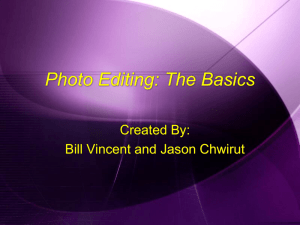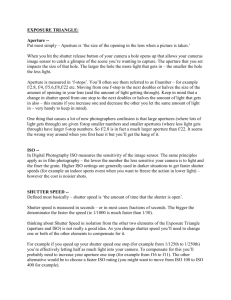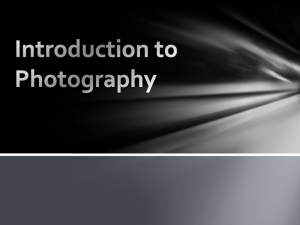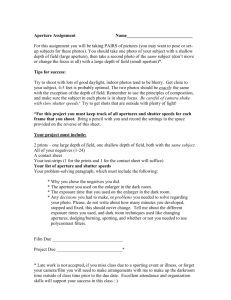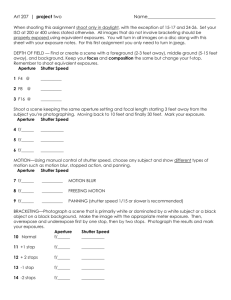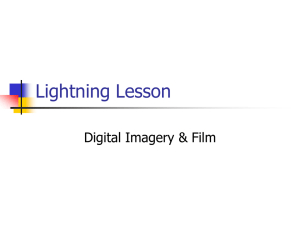Photography Basics
advertisement
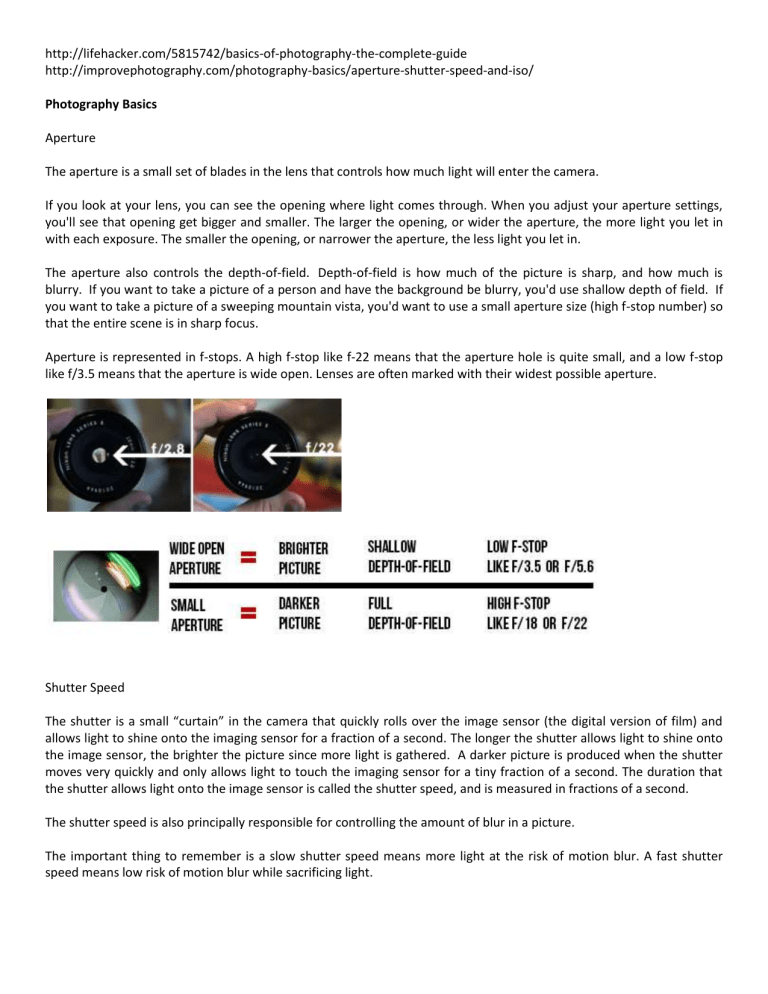
http://lifehacker.com/5815742/basics-of-photography-the-complete-guide http://improvephotography.com/photography-basics/aperture-shutter-speed-and-iso/ Photography Basics Aperture The aperture is a small set of blades in the lens that controls how much light will enter the camera. If you look at your lens, you can see the opening where light comes through. When you adjust your aperture settings, you'll see that opening get bigger and smaller. The larger the opening, or wider the aperture, the more light you let in with each exposure. The smaller the opening, or narrower the aperture, the less light you let in. The aperture also controls the depth-of-field. Depth-of-field is how much of the picture is sharp, and how much is blurry. If you want to take a picture of a person and have the background be blurry, you'd use shallow depth of field. If you want to take a picture of a sweeping mountain vista, you'd want to use a small aperture size (high f-stop number) so that the entire scene is in sharp focus. Aperture is represented in f-stops. A high f-stop like f-22 means that the aperture hole is quite small, and a low f-stop like f/3.5 means that the aperture is wide open. Lenses are often marked with their widest possible aperture. Shutter Speed The shutter is a small “curtain” in the camera that quickly rolls over the image sensor (the digital version of film) and allows light to shine onto the imaging sensor for a fraction of a second. The longer the shutter allows light to shine onto the image sensor, the brighter the picture since more light is gathered. A darker picture is produced when the shutter moves very quickly and only allows light to touch the imaging sensor for a tiny fraction of a second. The duration that the shutter allows light onto the image sensor is called the shutter speed, and is measured in fractions of a second. The shutter speed is also principally responsible for controlling the amount of blur in a picture. The important thing to remember is a slow shutter speed means more light at the risk of motion blur. A fast shutter speed means low risk of motion blur while sacrificing light. ISO ISO is the digital equivalent (or approximation) of film speed. If you remember buying film for a regular camera, you'd get 100 or 200 for outdoors and 400 or 800 for indoors. The faster the film speed the more sensitive it is to light. All of this still applies to digital photography, but it's called an ISO rating instead. A high ISO such as ISO 1,600 will produce a brighter picture than a lower ISO such as ISO 100. The drawback to increasing the ISO is that it makes the picture noisier. Digital noise is apparent when a photo looks grainy. The advantage of a low ISO is that the light in a given exposure is more accurately represented. If you've seen photos at night, the lights often look like they're much brighter and bleeding into other areas of the photo. This is the result of a high ISO—a greater sensitivity to light. High ISOs are particularly useful for picking up more detail in a dark photograph without reducing the shutter speed or widening the aperture more than you want to, but it comes at a cost. In addition to lights being overly and unrealistically bright in your photos, high ISO settings are the biggest contributors to photographic noise. Composition and Technique Rule of Thirds The rule of thirds is the simplest rule of composition. All you do is take your frame and overlay a grid of nine equal sections. This means you split the vertical space into three parts and the horizontal space into three parts. Generally you want to place important elements where the grid intersects. The intersection points are where the eye tends to go first, so it's useful to place your subject on one of those points. People generally tend to aim for the center, but that's often less effective. Perspective Photographing your subject straight-on is sometimes the right choice, but you can create visual impact by moving the camera left, right, above, and below. Use Shapes and Lines to Draw the Eye to a Specific Point The viewer's eye doesn't magically end up looking at one of the intersections in the rule of thirds grid, it's just more natural. That said, if you have a reason to draw the eye elsewhere you can accomplish that pretty easily by choosing where you place shapes and lines in your photograph. A shape doesn't mean a literal, detail-less shape, but in the sense that a building could serve as a rectangle. Roads often make nice lines in landscapes. When you're composing your photograph, consider the shapes and lines and where they draw your eye. If they're taking you out of the photograph or away from the primary subject, you'll probably want to consider a different composition. Frame Your Subject with Objects A subject against a white background can often be simple and effective if you have a good subject. If you have a boring subject, like an ordinary house, a blank background (like a clear sky) isn't going to be very compelling. Instead, try framing your subject with surrounding objects.
